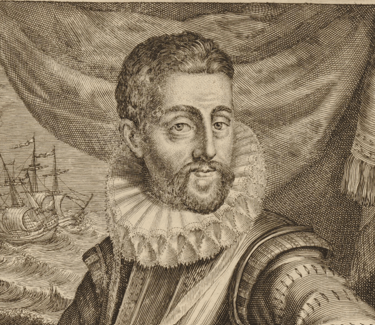The Mystery of Katherin: A Black Woman "Dwelling with the Prince of Portugal" in Tudor London
Discover Katherin, a Black woman "dwelling with the Prince of Portugal" in Tudor London. Uncover hidden stories of African women in 16th-century England.
BLACK HISTORYTUDORWOMENS HISTORY
6/15/20254 min read


The Untold Story of Katherin
On August 24, 1594, a woman named Katherin "the negar" was laid to rest in the churchyard of St. Stephen Coleman Street in London. Her burial record provides us with a tantalising glimpse into the life of a Black woman in Tudor England, yet it raises more questions than it answers. Who was Katherin, and how did she come to be "dwelling with the prince of Portugal" in Elizabethan London? Her story reveals the hidden Black Tudor history that mainstream narratives have long overlooked.
A Window into Medieval London
St. Stephen Coleman Street, also known as "St Stephen's in the Jewry", stood at the bustling corner of Coleman Street and what is now Gresham Street in the heart of the City of London. First mentioned in the 12th century, this ancient church served the community through centuries of change. During the medieval period, its status fluctuated between being a parish church and a chapel of ease to St. Olave Old Jewry, until its parochial status was permanently established in 1456. It was here, in this historic corner of London, that Katherin's earthly journey came to an end.
The Prince of Portugal: A Pretender in Exile
The "prince of Portingal" mentioned in Katherin's burial record was Don Antonio, Prior of Crato, a fascinating figure whose life reads like a political thriller. Born as the illegitimate son of Prince Luis, Duke of Beja (brother of King John III of Portugal), Don Antonio found himself thrust into the centre of one of Europe's great dynastic crises when the legitimate royal line died out.
When King Sebastian of Portugal died in 1578 without a clear successor, the throne passed to his grand-uncle, the elderly Cardinal Enrique. But when the Cardinal died in 1580, the Portuguese succession became a matter of international significance. Philip II of Spain, as the son of a Portuguese princess, had a strong dynastic claim to the Portuguese throne. Seeing an opportunity to unite the Iberian Peninsula under Spanish rule and gain control of Portugal's vast empire, Philip marshalled his forces.
Don Antonio, despite his illegitimate birth, also claimed the throne as the grandson of King Manuel I. In June 1580, Philip II invaded Portugal with nearly 40,000 troops under the command of the Duke of Alva. Don Antonio's resistance was valiant but ultimately futile. With only 8,000 men, he attempted to hold the strategic bridge of Alcántara on 25 August 1580, but was outmanoeuvred. Spanish forces seized Lisbon the following day, and Portuguese resistance throughout the empire largely collapsed, with only the Azores maintaining significant opposition to Spanish rule.
The Azores became Don Antonio's last stronghold. He initially repelled Spanish attacks in April 1581, but by July 1582, a much smaller Spanish force of 2,000 had expelled Don Antonio and his French allies. The final island, Terceira, surrendered in August 1583, and Don Antonio fled to France, his dream of ruling Portugal seemingly over.
The English Gambit and Exile in London
Don Antonio's story might have ended there, but the defeat of the Spanish Armada in 1588 rekindled his hopes. Ironically, this defeat was also Portugal's loss, as many of the ships in Philip's fleet were Portuguese galleons, including the flagship San Martin, which had sailed from Lisbon. The waste of Portuguese ships and sailors against England—traditionally Portugal's ally—increased anti-Spanish sentiment.
Capitalising on these feelings, Don Antonio returned to Portugal in 1589 with 20,000 troops, mostly English soldiers. But the campaign was a disaster. After plundering Corunna and making a futile landing at Peniche, the English abandoned the venture. Don Antonio discovered, to his dismay, that his countrymen were appalled at the prospect of Protestant Englishmen attempting to take Catholic Lisbon. Moreover, Philip II had kept his promises to respect Portuguese institutions, making Spanish rule more palatable than expected.
Defeated and disillusioned, Don Antonio returned to London, where he lived in exile until his death in 1595—just one year after Katherin's burial.
Black Tudor History: Katherin's Origins
The question of how Katherin came to be "dwelling with" Don Antonio remains one of the most intriguing aspects of her story. Historian Ungerer has suggested that she may have been enslaved, possibly acquired through Don Antonio's own involvement in sponsoring enslavement activities in West Africa.
However, there is another compelling possibility. Katherin might have been part of the Moorish population of Iberia. The Iberian Peninsula had a significant Black Moorish population, descendants of the Islamic conquest that began in 711 CE. When these populations were expelled or fled during the Christian Reconquista and later during periods of religious persecution, some found their way to other parts of Europe, including England.
Significantly, Katherin was never described as enslaved in the English parish records. The term "dwelling with" suggests she may have been a personal servant, but the exact nature of her relationship with Don Antonio remains unclear. Was she a trusted retainer who followed him into exile? A domestic servant? Or perhaps someone with her own agency who chose to remain with the exiled prince?
Black Tudors and Royal Households
Adding another layer to this historical mystery is Pedro Fernandes, described as a "mulatto", who arrived in England with Don Antonio. His presence suggests that the prince's household included multiple individuals of African or mixed African descent. This raises questions about whether there was a small community of Black individuals surrounding Don Antonio, perhaps people who had served his cause in Portugal or the Azores, or who had other connections to his political adventures.
The Enduring Mystery
We will never know with certainty how Katherin came to England or what her exact relationship was with the Prince of Portugal. The sparse historical record leaves us with more questions than answers.
What seems particularly intriguing is the unusual phrasing in her burial record. To be described as "dwelling with the prince of Portingal" suggests a relationship that was significant enough to define her identity in death, yet ambiguous enough to leave historians puzzling over its meaning centuries later.
Katherin's story reminds us that Tudor England was more diverse than we might imagine, and that behind every brief historical record lies a complex human story. Black Tudors like Katherin lived and worked throughout England, their lives intertwined with the grand political dramas of their age. In the bustling streets around St. Stephen Coleman Street, a Black woman lived and died, yet her own story remains tantalisingly just beyond our reach. Her burial record stands as testament to the hidden Black Tudor history waiting to be uncovered in parish records across England.
Discover more hidden Black Tudor stories on our Black Tudors Walk. Book your tour with Hidden Tudor Tours at www.hiddentudorstours.co.uk and explore the forgotten history of Black lives in Tudor London.
Don Antonio, Prior of Crato
Explore
Discover the hidden stories of Britain's Tudors.
Connect
Subscribe to Newsletter
contact@hiddentudorstours.co.uk
+44 (0)203 603 7729
© 2025. All rights reserved.
